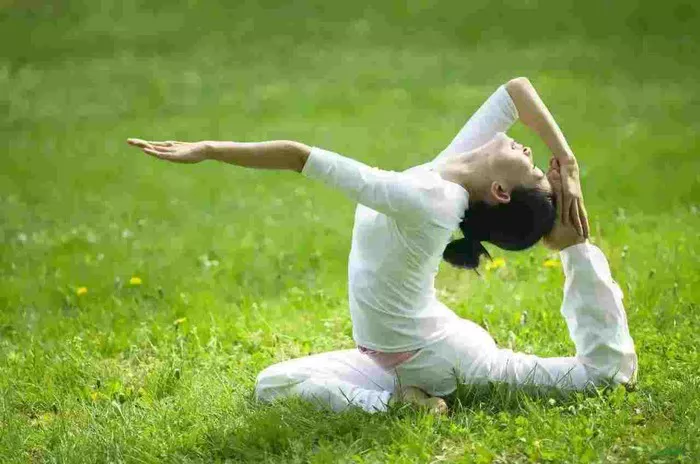Yoga, an ancient practice originating in India, has evolved into a global phenomenon celebrated for its multitude of benefits, including improved physical health, mental clarity, and spiritual growth. Among the many poses that make up a yoga practice, the Half Frog Pose (Ardha Bhekasana) stands out for its ability to stretch and strengthen the body in unique ways. This article delves into the details of what the Half Frog Pose is good for, exploring its benefits, technique, and the various ways it can enhance your practice.
What Is the Half Frog Pose
The Half Frog Pose, or Ardha Bhekasana, is a variation of the traditional Frog Pose (Bhekasana). The pose is a backbend and hip opener that requires a combination of flexibility, strength, and balance. It involves lying on your stomach, bending one knee towards the body, and holding the foot with one hand, while keeping the other leg extended behind you on the mat.
In this pose, the focus is on opening the chest and stretching the quads, hip flexors, and lower back. It is considered an intermediate posture, meaning it is suitable for those who have some experience with yoga and have already developed flexibility in their hips, thighs, and spine.
While the full Frog Pose requires both legs to be bent and held, the Half Frog Pose focuses on one side of the body at a time, offering a gentler approach for those still building flexibility and strength. This makes it an excellent choice for beginners or those working on improving their backbends.
The Physical Benefits of Half Frog Pose
1. Stretches the Hip Flexors and Quads
One of the main benefits of the Half Frog Pose is its deep stretch for the hip flexors and quadriceps. These muscle groups tend to become tight from prolonged sitting, standing, or physical activity such as running. Tight hip flexors can lead to discomfort and restricted movement, while tight quads may limit your ability to extend your legs fully.
By holding the foot of the bent leg in Half Frog Pose, you create a deep stretch in the quadriceps, which helps to release tension and increase flexibility. The position also stretches the hip flexors, which can relieve tightness and improve range of motion in the hips.
2. Improves Spine Flexibility and Posture
The Half Frog Pose requires a backbend, which is a fantastic way to improve spinal flexibility. As you draw the foot towards your body and lift your chest upwards, you encourage extension of the spine and gentle compression in the lower back. This helps to increase spinal mobility, which is essential for overall posture and comfort.
Regular practice of this pose helps counteract the effects of slouching and prolonged sitting, both of which contribute to poor posture. By creating space between the vertebrae and opening the chest, the Half Frog Pose helps maintain the natural curvature of the spine, which can reduce back pain and stiffness.
3. Strengthens the Lower Back and Core Muscles
While the Half Frog Pose stretches the front of the body, it also engages the muscles along the back, especially the lower back and core. To maintain balance in the pose, you need to activate the muscles of the back and core to hold the position and prevent collapsing into the mat.
This engagement helps to build strength in the lower back, which is crucial for overall stability and injury prevention. The core muscles also play an important role in stabilizing the body, making the Half Frog Pose an excellent exercise for improving overall core strength.
4. Opens the Chest and Shoulders
As a backbend, the Half Frog Pose naturally encourages an opening of the chest and shoulders. The act of lifting the chest and drawing the foot towards the body helps to expand the ribcage, allowing for deeper breathing. This chest opening is beneficial for individuals who spend a lot of time hunched over computers or devices, as it helps to reverse the effects of forward hunching and tight shoulders.
Opening the chest in this way also improves lung capacity and can help alleviate symptoms of stress and anxiety by encouraging full, deep breaths. Additionally, the stretch in the shoulders can help reduce tension in the upper body, promoting relaxation.
5. Stimulates Digestive Organs
The Half Frog Pose, like many backbends, has a gentle massaging effect on the internal organs. By extending the spine and lifting the chest, the pose creates space in the abdomen, allowing for improved blood flow to the digestive organs. This can aid in digestion and help alleviate constipation or bloating.
The deep stretching and opening of the body also encourage the release of stored tension, which can have a positive impact on overall digestive health. Regular practice of the Half Frog Pose can help keep the digestive system functioning optimally.
Mental and Emotional Benefits
In addition to its physical benefits, the Half Frog Pose also provides mental and emotional advantages. Yoga, as a holistic practice, addresses not only the body but also the mind and spirit. Here’s how the Half Frog Pose can support emotional well-being:
1. Encourages Mindfulness and Focus
Yoga postures like the Half Frog Pose require concentration and mindfulness to perform correctly. As you hold the position, it becomes essential to focus on your breath, alignment, and body sensations. This focused attention helps to quiet the mind, reduce mental chatter, and cultivate mindfulness.
The act of being present in the pose allows you to disconnect from the outside world and focus on your inner experience, which can be grounding and calming. This mindfulness can carry over into other areas of life, helping you approach challenges with a sense of clarity and composure.
2. Reduces Stress and Anxiety
Backbends, including the Half Frog Pose, are known for their ability to activate the parasympathetic nervous system, which promotes relaxation and reduces stress. By opening the chest and encouraging deep breathing, the pose helps to balance the body’s stress response and release tension.
Practicing the Half Frog Pose can provide an emotional release, particularly for those dealing with stress or anxiety. The deep stretches and chest opening can help you feel more expansive, both physically and emotionally, which fosters a sense of calm and well-being.
3. Improves Emotional Resilience
Yoga postures that involve deep stretching and backbending can also help to release pent-up emotions. The Half Frog Pose, by stretching and opening the body, encourages the release of emotional blockages that may have accumulated over time. This emotional release can contribute to greater emotional resilience and a sense of emotional balance.
Regular practice of the Half Frog Pose can help you navigate challenging emotions and experiences with more ease and a greater sense of stability. It promotes self-awareness and self-acceptance, which are crucial for emotional healing and growth.
How to Perform the Half Frog Pose
Here is a step-by-step guide on how to perform the Half Frog Pose correctly:
Start on Your Stomach: Lie on your belly with your legs extended straight behind you, hip-width apart. Keep your arms resting at your sides, palms facing down.
Bend One Knee: Gently bend your right knee, bringing your heel toward your glutes. Keep your left leg extended behind you, pressing the top of the foot into the mat.
Reach for Your Foot: With your right hand, reach back and grab hold of the outside of your right foot or ankle. If this is too challenging, you can use a strap around your foot to help bring it closer to your body.
Lift Your Chest: Press your chest forward and slightly up, lifting your torso off the mat. Keep your gaze forward or slightly upward, avoiding arching your neck too much.
Engage Your Core: To maintain stability, engage your core muscles and keep your back muscles active. This helps prevent strain in the lower back.
Hold and Breathe: Hold the pose for 20-30 seconds, breathing deeply and steadily. Focus on your breath and feel the stretch along the front of your body and the opening in your chest.
Release and Repeat: Slowly release the foot and return to the starting position. Repeat the pose on the other side, bending your left knee and holding the left foot.
Modifications and Precautions
While the Half Frog Pose offers numerous benefits, it is important to approach it with care and mindfulness. Here are a few modifications and precautions to consider:
Knee Sensitivity: If you have knee issues, avoid placing too much pressure on the knee. Use a blanket or cushion underneath the bent knee for extra support, or opt for a modified version of the pose with less bend in the knee.
Lower Back Sensitivity: If you experience discomfort in your lower back, practice this pose with caution. Engage your core to protect your spine and avoid overextending in the backbend.
Neck Issues: Keep your neck in line with your spine to avoid strain. If you feel any discomfort in your neck, release the pose and rest.
Using a Strap: If you cannot reach your foot, use a yoga strap around your ankle to help you hold the position without straining your arm or shoulder.
Conclusion
The Half Frog Pose is a powerful yoga posture with a multitude of physical, mental, and emotional benefits. It stretches and strengthens key muscle groups, opens the chest and hips, and helps to improve flexibility and posture. Additionally, it provides emotional release and promotes mindfulness, making it a valuable addition to any yoga practice.
Whether you are looking to alleviate tightness in your hips, improve your spinal flexibility, or reduce stress and anxiety, the Half Frog Pose offers a range of benefits that can enhance your overall well-being. With regular practice and attention to proper alignment, you can fully experience the advantages of this transformative pose.
Related Topics:
























